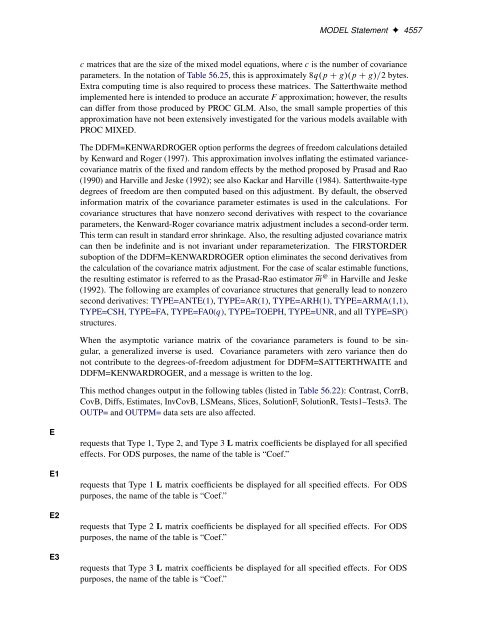SAS/STAT 922 User's Guide: The MIXED Procedure (Book Excerpt)
SAS/STAT 922 User's Guide: The MIXED Procedure (Book Excerpt)
SAS/STAT 922 User's Guide: The MIXED Procedure (Book Excerpt)
You also want an ePaper? Increase the reach of your titles
YUMPU automatically turns print PDFs into web optimized ePapers that Google loves.
E<br />
E1<br />
E2<br />
E3<br />
MODEL Statement ✦ 4557<br />
c matrices that are the size of the mixed model equations, where c is the number of covariance<br />
parameters. In the notation of Table 56.25, this is approximately 8q.p C g/.p C g/=2 bytes.<br />
Extra computing time is also required to process these matrices. <strong>The</strong> Satterthwaite method<br />
implemented here is intended to produce an accurate F approximation; however, the results<br />
can differ from those produced by PROC GLM. Also, the small sample properties of this<br />
approximation have not been extensively investigated for the various models available with<br />
PROC <strong>MIXED</strong>.<br />
<strong>The</strong> DDFM=KENWARDROGER option performs the degrees of freedom calculations detailed<br />
by Kenward and Roger (1997). This approximation involves inflating the estimated variancecovariance<br />
matrix of the fixed and random effects by the method proposed by Prasad and Rao<br />
(1990) and Harville and Jeske (1992); see also Kackar and Harville (1984). Satterthwaite-type<br />
degrees of freedom are then computed based on this adjustment. By default, the observed<br />
information matrix of the covariance parameter estimates is used in the calculations. For<br />
covariance structures that have nonzero second derivatives with respect to the covariance<br />
parameters, the Kenward-Roger covariance matrix adjustment includes a second-order term.<br />
This term can result in standard error shrinkage. Also, the resulting adjusted covariance matrix<br />
can then be indefinite and is not invariant under reparameterization. <strong>The</strong> FIRSTORDER<br />
suboption of the DDFM=KENWARDROGER option eliminates the second derivatives from<br />
the calculation of the covariance matrix adjustment. For the case of scalar estimable functions,<br />
the resulting estimator is referred to as the Prasad-Rao estimator em @ in Harville and Jeske<br />
(1992). <strong>The</strong> following are examples of covariance structures that generally lead to nonzero<br />
second derivatives: TYPE=ANTE(1), TYPE=AR(1), TYPE=ARH(1), TYPE=ARMA(1,1),<br />
TYPE=CSH, TYPE=FA, TYPE=FA0(q), TYPE=TOEPH, TYPE=UNR, and all TYPE=SP()<br />
structures.<br />
When the asymptotic variance matrix of the covariance parameters is found to be singular,<br />
a generalized inverse is used. Covariance parameters with zero variance then do<br />
not contribute to the degrees-of-freedom adjustment for DDFM=SATTERTHWAITE and<br />
DDFM=KENWARDROGER, and a message is written to the log.<br />
This method changes output in the following tables (listed in Table 56.22): Contrast, CorrB,<br />
CovB, Diffs, Estimates, InvCovB, LSMeans, Slices, SolutionF, SolutionR, Tests1–Tests3. <strong>The</strong><br />
OUTP= and OUTPM= data sets are also affected.<br />
requests that Type 1, Type 2, and Type 3 L matrix coefficients be displayed for all specified<br />
effects. For ODS purposes, the name of the table is “Coef.”<br />
requests that Type 1 L matrix coefficients be displayed for all specified effects. For ODS<br />
purposes, the name of the table is “Coef.”<br />
requests that Type 2 L matrix coefficients be displayed for all specified effects. For ODS<br />
purposes, the name of the table is “Coef.”<br />
requests that Type 3 L matrix coefficients be displayed for all specified effects. For ODS<br />
purposes, the name of the table is “Coef.”

















